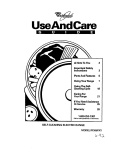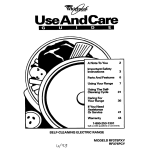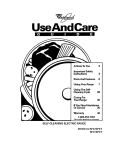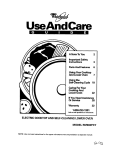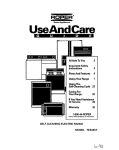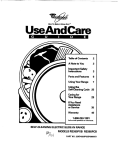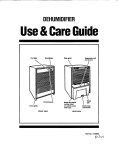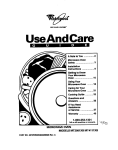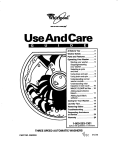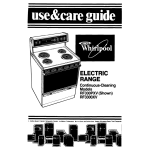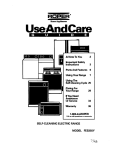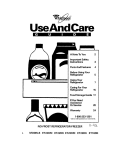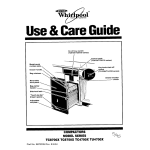Download Roper FES385Y Range User Manual
Transcript
A Note To You 2 Important Safety lnsbuctions 3 Parts And Features 6 Using Your Range 7 Usin The Self -8 leaning Cycle 22 Caring For Your Range 25 If You Need Assistance 29 Or Sewice 32 Warranty 1-800~44-ROPER Call us with SELF-CLEANING questions or comments. ELECTRIC RANGE MODEL FES385Y A Note To You Thank you for buying a Roper appliance. You have purchased a quality, worMclass home appliance. Years of engineering experience have gone into its manufacturing. To ensure that you will enjoy many years of trouble-free operation, we have developed this Use and Care Guide. It is full of valuable information on how to operate and maintain your appliance properly and safely. Please read it carefulfy. Also, please complete and mail the Ownership Registration Card provided with your appliance. This will help us notify you about any new information on your appliance. Your safety is important to us. This guide contains safety symbols and statements. Please pay special attention to these symbols and follow any instructions given. Here is a brief explanation of the use of each symbol. This symbol will help you avoid actions which could cause product damage (scratches, dents, etc.) and damage to your personal property. This symbol will help alert you to such dangers as personal injury, burns, fire and electrical shock. Our toll-free number, l-800-44-ROPER available 24 hours a day. (l-800-447-6737). is ff you ever have a question concerning your appliance’s operation, or if you need service, first see ‘If You Need Assistance Or Service” on page 29. If you need further help, feel free to call us. When calling, you will need to know your appliance’s complete model number and serial number. You can find this information on the model and serial number plate (see diagram on page 6). For your convenience, we have included a handy place below for you to record these numbers, the purchase date from the sales slip and your dealer’s name and telephone number. Keep this book and the sales slip together in a safe place for future reference. Model Number Dealer Name Serial Number Dealer Phone Purchase Date Important Safety Instructions General l l Read all instructions before using the range. install or locate the range only in accordance with the provided Installation Instructions. l l l l l l l WARNING: To reduce the risk of ti ping of the appliance, the app Piance must be secured by a proper1 installed anti-tip bracket. f! o check if the bracket is installed properly, see ‘The anti-tip bracket” on page 21. CAUTION: Do not store things children mi ht want above the range. Chil iI ren could be burned or injured while climbing on it. Do not leave children alone or unattended in area where the range is in use. They should never be allowed to sit or stand on an part of the range. They could K e burned or injured. Do not operate the range if it is damaged or not working properly. Do not use the range for warming or heatin the room. Persons could be %urned or injured, or a fire could start. l Use the range only for its intended use as described in this manual. Do not touch surface units, areas near units, heating elements or interior surfaces of oven. Surface units and heating elements may be hot even though they are dark in color. Areas near surface units and interior surfaces of an oven become hot enou h to cause burns. During an ? after use, do not touch, or let clothing or other flammable materials contact surface units, areas near units, heatin elements or interior surfaces 09 oven until they have had sufficient time to cool. Other surfaces of the Do not wear loose or hanging garments when using the range. They could ignite if they touch a hot surface unit and you could be burned. continued on next page 3 Use only d potholders. Moist or damp po7 holders on hot surfaces ma result in burns from steam. ‘b o not let potholder touch hot heating elements. Do not use a towel or bulk cloth for a potholder. It coul 2 catch on fire. l Keep range vents unobstructed. l Do not heat unopened containers. They could explode. The hot contents could cause burns and container particles could cause injury. l Do not store flammable materials on or near the range. The fumes can create an explosion and/or fire hazard. When using the cooktop l l l l Select a pan with a flat bottom that is about the same size as the surface unit. If pan is smaller than the surface unit, some of the heating element will be exposed and may result in the igniting of clothing or potholders. Correct pan size also improves cooking efficiency. Check to be sure glass cooking utensils are safe for use on the range. Only certain types of glass, glass-ceramic, ceramic, earthenware or other glazed utensils are suitable for cooktops without breaking due to the sudden change in temperature. Never leave surface units unattended at high heat settings. A boilover could result and cause smoking and greasy spillovers that may ignite. Turn pan handles inward, but not over other surface units. This will help reduce the chance of burns, i niting of flammable materia 9 s, and spills due to bumping of the pan. When using the oven l l l Always position oven rack(s) in desired location while oven IS cool. If a rack must be removed while oven is hot, do not let potholder contact hot heating element in oven. Use care when opening oven door. Let hot air or steam escape before removing or replacing food. Grease l Grease is flammable. Do not allow grease to collect around cooktop or in vents. Wipe spillovers immediately. l Do not use water on grease fires. Never pick up a flaming pan. Smother flaming pan on range by coverin with a wellfitted lid, cookie s7-leet or flat tray. Flaming grease outside of an can be extin uished with Eaking soda or, i9 available, a multipurpose dry chemical or foam-type extinguisher. Care and cleaning l l l Small amounts of’formaldehyde and carbon monoxide are iven off in the Self-Cleaning cyc9e from fiberglass insulation and food decomposition. Significant exposure to these substances can cause cancer or reproductive harm. Exposure can be minimized by venting with a hood or open window and wiping out excess food spills pnor to self-cleaning. l l l Do not use oven cleaners. No commercial oven cleaner or oven liner rotective coating of any kind s Rould be used in or around any part of the oven. Before self-cleaning the oven., remove broiler an, broiler nd, oven racks an cf other utensr9 s. Do not use your oven to clean miscellaneous parts unless you are instructed to do so in this Use and Care Guide. Do not clean door heat seal. It is essential for a good seal. Care should be taken not to rub, damage or move the seal. Clean only parts recommended in this Use and Care Guide. Do not repair or replace any part of the range unless specifically recommended in this manual. All other servicing should be referred to a qualified technician. Disconnect the electrical supply before servicing the range. - SAVE THESE INSTRUCTIONS - 5 Parts And Features This section contains captioned illustrations of your range. Use them to become familiar wfih the location and appearance of all parts and features. Anti-tip bracket (on wall behind conbol panel) Control Oven vent panel - Automatic Removable storage Control panel Left Manual Left rear front control knob , I Surface oven control knob I unit marker oven light switch I Electronic clock with oven controls and minute timer I Right rear control knob Right front control knob I Surface unit indicator light Using Your Range In This Section Using the wrface racks nd Positioning For beat air circulation Using aluminum The electronic Setting pans ..- ..--.. . . . ..-... clocWoven controls I...........I. the clock ..-........s................................. Using the BetCancel Bakhghoasting 7 Adjusting 6 Broiling . . . . . . . . . . . . . . . . ..I....m......M..... 9 foil for baking . ..“.............“... Using the’electronic PWW Paw units . . . . . . . . . . ..I.-..................... 10 Broiling Energy the oven temperature control -.... 14 15 “.l.U.“..._.................-....-...............“. tips . . . . . . .. . .. . . . . . . . . . . . . . . . ..-...............IU....... 16 saving tips .. . . I . . . . . “” . . . . . . . . .. . . . . . I . . . . . -. 10 Using the electronic 11 The oven vent . . . . . . . ..--. clocWoven -- 17 control “...... 17 “..-............ -20 Minute Timer . . . ..“. . “..... 12 The rtorage drawer .. . ... .....“.““..“............“...... 21 button . . . . . . . ..I . . . . .. . . . . . . . . . . . 12 The anti-tip bracket 21 ” . . . . . . . . . . . . . . . . ...” . . . . . . . . . . . *. . . .. “I... 13 Optional . . . . . . . . ..“I....“..........-..“.“.. door panel pat . . . . . . . . . . . . . . . . . . . .. . . . . . . . . . . . . . 21 To obtain the best cooking resutts possible, you must operate your range properly. This section gives you important information for efficient and safe use of your range. Using the surface units Control knobs must be pushed in before turning them to a setting. They can be set anywhere between HI and OFF. Surface unit markers The solid dot in the surface unit marker shows which surface unit is turned on by that knob. Surface unit indicator lights One of the Surface Unit Indicator Lights on the control panel will glow when a surface unit is on. Burn and Fire Hazard Be sure all control knobs are turned to OFF and all indicator lights are OFF when you are not cooking. Someone could be burned or a fire could start if a surface unit is accidentally left ON. 7 Cookware Until you get used to the settings, use the following as a guide. For best results, start cooking at the high settings; then turn the control knob down to continue cooking. Sl3llNG HI l l MEDHI l l MED l l MED-LO LO I Solid l l RECOMMENDED USE To start foods cooking. To bring liquids to a boil. To hold a rapid boil. To fry chicken or pancakes. For gravy, pudding and icing. To cook large amounts of vegetables. To keep food cooking after starting it on a higher setting. To keep food warm until ready to serve. element surface units Solid element surface units are made of heavy cast-iron to provide even cooking. Each surface unit has a built-in protective limiter as a safety feature. The limiter senses uneven cooking temperatures when: l A pan boils dry. l A pan is removed and the surface unit is left on. l The bottom of the pan is too large or too small for the element. This will result in longer cooking times. The limiter will automatically reduce the heat level to provide even cooking temperatures. NOTE: Solid elements stay hot for a long time. Do not use the HI setting for long periods of time or leave pans on hot elements when cooking is done. Burned food and damage to the cookware could result. Use a lower setting to complete the cooking and turn the solid element surface unit off a few minutes before you finish cooking. l Do not leave an empty utensil, or one which has boiled dry, on a hot surface unit. It can overheat and may damage the utensil or surface unit. l Do not use canners, woks and speciatly utensils with rounded, warped, ridged or dented bottoms. These could cause severe overheating which damages the utensil andlor surface unit. Before placing a pan on solid element surface units for the first time, heat on HI setting for five minutes. The surface units will give off smoke as the protective coating, applied at the factory, finishes bonding to the surface. l El I tips There is no one brand of cooking utensil that is best for all people. Knowing something about pan materials and construction will help you select the correct cooking utensils for your needs. l For best results and greater energy efficiency, use only flat-bottomed utensils that make good contact with the surface units. To check the flatness of a utensil: -Turn it over and check the bottom of the pan by placing a ruler across it. -Rotate the ruler in all directions. There should be no gaps between the pan and the ruler. NOTE: Woks, canners and teakettles with flat bottoms suitable for use on your cooktop are now available in most houseware stores or departments. l The pan should have straight sides and a tightfitting lid. l Choose medium to heavy gauge (thickness) pans that are fairly lightweight. Remember that a very heavy pan will be even heavier when filled with food. l The pan material (metal or glass) affects how fast heat transfers from the surface unit through the pan material and how evenly heat spreads over the pan bottom. Choose pans that provide the best cooking results. l Handles should be made of a sturdy, heat-resistant material and be securely attached to the pan. Home canning information The large diameter of most water-bath or pressure canners combined with high heat settings for long periods of time can shorten the life of surface units and cause damage to the cooktop. To protect your range: l Use flat-bottomed canners/pans for best results. Some canners have ridged bottoms (porcelain enamel-ware) and are not recommended. They do not make good contact with the surface unit and cause severe overheating which damages the cook-top. l For best results, use the largest surface unit. Also, use a canner/pan which can be centered over the surface unit and which does not extend more than one inch outside surface unit area. Large diameter canners/pans, if not properly centered, trap heat and can cause damage to the cooktop. l Do not place canner on two surface units at the same time. Excessive heat build-up will damage the cooktop. l Start with hot water. This reduces the time the control is set on high. Reduce heat setting to lowest position needed to keep water boiling. Positioning racks l To prolong the life of the elements: - Prepare small batches at a time. - Do not use elements for canning all day. and pans For baking/roasting with one rack, the rack should be placed so the top of the food will be centered in the oven. Always leave at least 1 ‘/z to 2 inches (4-5 cm) between the sides of the pan and the oven walls and other pans. For proper cooking, follow these guidelines for specific foods: l Angel and bundt cakes, yeast breads, frozen pies, large roasts and turkeys-place rack on lowest level. l Casseroles, muffins, most quick breads and meats-place rack on second or third level from bottom. l Cookies, biscuits, cakes and non-frozen piesplace rack on second or third level from bottom. When baking on two racks, arrange racks on bottom and third level from bottom. NOTE: For recommended rack placement when broiling, see “Broiling rack position chart” on page 16. For best air circulation The hot air must circulate around the pans in the oven for even heat to reach all parts of the oven. This results in better baking. l Place the pans so that one is not directly over the other. l Allow 1% to 2 inches (4-5 cm) of space around each pan and between pans and oven walls. l Use only one cookie sheet in the oven at one time. Use the following as a guide to determine where to place the pans. One pan Place in the center of the oven rack. Two pans Place in opposite corners of the oven rack. Three or four pans Place in opposite corners on each oven rack. Stagger pans so no pan is directly over another. NOTE: “oven peeking” may cause heat loss, longer cooking times and unsatisfactory baking or roasting results. Use a reliable kitchen timer to keep track of the cooking time. Personal Injury Hazard Always position oven rack(s) in desired location before turning oven on. Be sure the rack(s) is level. l lf rack(s) must be moved while oven is hot, use potholders or oven mitts to protect hands. Failure to follow the above precautions may result in personal injury. l Using aluminum foil for baking Use aluminum foil to catch spillovers from pies or casseroles. l Place the foil on the oven rack below the rack with the food. The foil should have the edges turned up and be about 1 inch (3 cm) larger all around than the dish holding the food. l Do not cover the entire rack with aluminum foil. ft will reduce air circulation and cause poor cooking results. l Do not line oven bottom or entire oven rack with foil or other liners. Poor baking will result. Electricel Shock and Fire Hazard Do not allow foil to touch the heating elements because it will damage them and could result in shock or fire hazard. The electronic clock/oven There are three parts in the clockloven control section: -The display -The command buttons -The TimeITemp Set Knob Instructions for the oven control are covered on the following pages. Read them carefully. When you first plug in the range, the last time of day set will show in the display. If, after you set the clock (page 11) the display again shows the last time of day set, your electricity was off for a while. Reset the clock. 10 controls Display/clock When you are not using the oven, this is an accurate clock When using the oven or Minute Timer, the display will show the time, temperature settings and what command buttons have been pressed. When showing the time of day, the display will show the hour and minutes. When using the Minute Timer. the display shows minutes and seconds in the following sequence: l For settings from O-l minute 55 seconds, the display will increase in 5-second increments and count down each second. l For settings from 2-10 minutes, the display will increase in 1O-second increments and count down each second. l For settings from lo-60 minutes, the display will increase in l-minute increments and count down each second. For settings from l-2 hours, the display will increase in 5minute increments and count ., down each minute. l For settings from 2 hours-g hours 50 minutes, the display will increase in lo-minute increments and count down each minute. When using Cook Time ancYor Stop Time. the display shows hours and minutes. l Command buttons The command buttons tell the oven what to do and in what order. A few examples: -Clock tells the oven you are going to set the clock -Set/Cancel tells the oven to turn off. Each command button (except Set/Cancel) has its own indicator. The indicator comes on when you touch the command button. Time/Temp Set Knob Once you’ve pushed a command button to tell the oven what you want it to do, you’ll use the Time/ Temp Set Knob to set a temperature or time. Turning the Time/Temp Set Knob clockwise increases the number on the display. Turning the Time/Temp Set Knob counterclockwise decreases the number on the display. Setting the clock 1. Push the Clock button. TIME will light up in the display. 2. Turn the TimelTemp Set Knob until the correct time shows in the display. 3. Push tha Set/Cancel operation. button to start clock 11 Using the electronic Minute The Minute Timer does not start or stop the oven. lt works like a kitchen timer. lt can be set in minutes and seconds up to 9 hours and 50 minutes. You will hear 3 tones when the set time is up. 1. Push the Timer button. TIMER will come on and the display will show ‘:OO”. 2. Turn the TimeITemp Set Knob until the desired time shows in the display. The Minute Timer will begin counting down 2 seconds after the time is set, When time is up, you will hear 3 tones, then one tone every 10 seconds until you push the Timer button. To cancel l l the Minute Timer: Push and hold the Timer button until the time of day shows in the display. OR Push the Timer button and turn the Time/Temp Set Knob until the time of day shows in the display. Using the Set/Cancel The Set/Cancel button will cancel any command button except for the Timer button. When the Set/ Cancel button is pushed, the large display will show the time of day. 12 button Timer Baking/roasting 1. Position the rack(s) properly before turning on the oven. To change rack position, lift rack at front and pull out. For further information, see “Positioning racks and pans’ on page 9. 2. Push the Bake Temp button. The small display will show “--OF and BAKE will come on. 3. Turn the Time/Temp Set Knob until the desired temperature shows in the small display. Once the temperature is set, ON will come on. NOTE: lf a bake/roast temperature is not set within 30 seconds of pushing the Bake Temp button, BAKE and “--OF will disappear from the display. 4. When baking, preheat the oven. (Preheating is not needed when roasting.) The oven is preheated when you hear one tone and the set temperature shows in the small display. NOTE: The small display will show the actual oven temperature in 5” increments, starting at loo’, while the oven is preheating. 5. Put food in the oven. During bating/roasting, the elements will turn on and off to keep the oven temperature at the setting. NOTE: The top element helps heat during baking/roasting, but does not turn red. 6. When bakindrosting is done, push the Set/ Cancel button. The time of day will show in the display. 13 Adjusting the oven temperature Does your oven seem hotter or colder than your old oven? The temperature of your old oven may have shifted gradually without you noticing the change. Your new oven is properly adjusted to provide accurate temperatures. But, when compared to your old oven, the new design may give you different results. If, after using the oven for a period of time, you are not satisfied with the temperature settings, they can be adjusted by following these steps: 1. Push the Bake Temp button. Turn the Time/ Temp Set Knob clockwise to a temperature setting above 500°F. 2. Immediately push and hold the Bake Temp button again until the display shows “00”. 3. Turn the TimeITemp Set Knob until the desired temperature change (between -35’F and +35”F) shows in the display. 4. Push the Set/Cancel temperature. 14 button to enter the new control Broiling 1. Position the rack before turning the oven on. See “Broiling rack position chart” on page 16. 2. Put the broiler pan and food on the rack 3. Close the door to the Broil Stop position (open about 4 inches [lo.2 cm]). The door will stay open by itself. NOTE: The door must be partly open whenever the oven is being used to broil. Leaving the door open allows the oven to maintain proper temperatures. 4. Push the Broil button. The small display will showy--’ and BROIL will come on. 5. Turn the TimeITemp Set Knob until the desired broiling setting shows in the small display (1,2.3,4, 5, HI). Hi-Broil element on 100% of the time 5-Broil element on 90% of the time 4-Broil element on 80% of the time 3-Broil element on 70% of the time 2-Broil element on 60% of the time l-Broil element on 50% of the time Most broiling is done at the HI setting. lf food is cooking too fast, broil times can be varied by using broil settings 1 through 5. NOTE: Fish and chicken are some foods that may cook better if you use lower broiling temperatures. 6. When broiling is done, push the Set/Cancel button. Time of day will show in the display. 15 Broiling rack RACK POSfTlON FROM BOTTOM l l chart TYPE OF FOOD/ DONENESS 4 Quickty searing food, rare steaks 3 Medium steaks and patties, ham slices, fish steaks, frankfurters 2 Well-done steaks and patties, lamb chops, split chicken, pork steaks and chops, whole fish Broiling l position tips Use the broiler pan and grid for broiling. They are designed to drain excess liquid and fat away from the cooking surface to help prevent spatter, smoke or fire. Refer to a broiling chart in a reliable cookbook for correct broiling times. After broiling, remove the broiler pan from the oven when you remove the food. Drippings will bake on the pan if it is left in the heated oven. 16 l l Fire Hazard Place meat the correct distance from the element. Meat placed too close to the element may spatter, smoke, bum or catch fire during broiling. To ensure adequate grease drainage, do not use cookie sheets or similar pans for broiling. Also, covering the broiler grid with foil is not recommended. Poor drainage of grease may result in fire. lf foil is used, cut slits in foil to correspond with all openings in broiler grid. Grease can then drain away and cool in pan. Energy saving tips Although the energy used for cooking is usually a very small percentage of the total energy used in the home, cooking energy can be used efficiently. Here are some tips to help you conserve energy when using your cooking product. l Use pans with flat bottoms, straight sides and tight-fitting lids. l Match the pan to the surface unit size. l Cook with a minimum of liquid or fat to help shorten cooking time. l Preheat pans only when recommended and for the shortest time possible. l Start food on higher heat settings, then set surface unit control on low or off to finish cooking. Use retained heat for cooking when possible. l Use the more efficient surface units instead of the oven when possible. Using the electronic l l l l l l Turn on the surface unit only after placing filled pan on the unit. “Oven peeking” may cause heat loss, longer cooking times and unsatisfactory baking resutts. Rely on your timer. Bake cakes, pies or cookies when oven is warm. Best time is after a meal has been cooked in it. Preheat the oven no longer than necessary. Plan your meals for the most efficient use of the range. When using the oven to cook one food, try to cook the rest of the meal in it also. Do not preheat when broiling, roasting or cooking items such as casseroles. clock/oven control The electronic clock/oven control will turn the oven on and off at times you set . . . even when you are not around. Automatic bakinq/roasting is ideal for foods which do not require a preheated oven, such as meats and casseroles. Do not use the automatic cycle for cakes, cookies, etc. . . . undercooking will result. To start baking/roasting and stop automatically now 1. Position the oven rack(s) property and put food in the oven. 2. Make sure the clock is set to the correct time of day. (See “Setting the clock” on page 11.) 3. Push the Cook Time button. OVEN, TIME and HR will come on. ON will not come on until the time of day that oven is to be turned on is reached. If you start baking/roasting immediately, ON will come on. 17 4. Turn the Time/Temp Set Knob clockwise until the desired baking/roasting time shows in the large display. When you are using the Cook Time a&or Stop Time button, the display shows hours and minutes in the following sequence: l For settings from O-2 hours, the display will increase in first a lo-minute increment, then 5-minute increments. l For settings from 2 hours-l 1 hours 55 minutes, the display will increase in 5-minute increments. The small display and BAKE will flash and a tone will keep sounding until Step 5 is done. 5. Push the Bake Temp button and set the desired baking/roasting temperature. The small display will show the set temperature while the large display shows the remaining bakingroasting time. OVEN, TIME. HR, BAKE and ON will come on. 6. The large display will count down in minutes. The small display will show the actual oven temperature until the set temperature is reached. A tone will sound at that time. 7. When the baking/roasting time is completed, three tones will sound. The large display will show “0:OO” and OVEN, TIME and HR will come on. A tone will sound every 10 seconds until the Set/Cancel button is pushed. 8. Push the Set/Cancel button to return to the time of day. If the Set/Cancel button is not pushed, a tone will sound every 10 seconds. 18 To delay start automatically and stop 1. Position the oven rack(s) properly and put food in the oven. 2. Make sure the clock is set to the correct time of day. (See Setting the cloclc on page 11.) 3. Push the Cook Time button. OVEN, TIME and HR will come on. ON will not come on until the time of day that oven is to be turned on is reached. 4. Turn the Time/Temp Set Knob clockwise until the desired baking/roasting time shows in the large display. The small display and BAKE will flash and a tone will keep sounding until Step 5 is done. 5. Push the Stop Time button. The large display will show the current stop time and STOP TIME will come on. Turn the Time/Temp Set Knob clockwise until the desired stop time shows in the display. DELAY and OVEN will come on. The small display and BAKE will flash and a tone will keep sounding until Step 6 is done. 6. Push the BakefTemp button and set the desired baking/roasting temperature. 7. Changes can be made at any time by pushing a command button. 19 8. When OVEN actual STOP the start time is reached, DELAY and will go off. The display will show the oven temperature and the stop time. TIME. BAKE and ON will come on. 9. When the bakjng/roasting time is completed, three tones will sound. The large display will show “0:Oo” and OVEN, TIME and HR will come on. A tone will sound every 10 seconds until the Set/Cancel button is pushed. To cancel automatic control qettings: Push the Set/Cancel oven button. To avoid sickness and food waste when using delay start: l Do not let most UNFROZEN food stand for more than two hours before cooking starts. l Do not allow food to remain in oven for more than two hours after the end of cooking cycle. NOTE: Do not use foods that will spoil while waiting for cooking to start. Such foods are: dishes with milk or eggs, cream soups and cooked meats or fish. Also, foods containing baking powder or yeast will not rise properly when cooked using delay start. The oven vent Hot air and moisture escape from the oven through a vent on the backguard below the control panel. The vent is needed for air circulation. Do not block the vent. Poor baking/roasting can result. 20 Oven vent The storage drawer The storage drawer is for storing pots and pans. The drawer can be removed to make it easier to clean under the range. Use care when handling the drawer. Removing the storage drawer: 1. Empty drawer of any pots and pans before removing drawer. Pull drawer straight out to the first stop. Lii front and pull out to the second stop. 2. Lii back slightly and slide drawer all the way out. Replacing the storage drawer: 1. Fit ends of drawer slide rails into the drawer guides on both sides of opening. 2. Lii drawer front and push in until metal stops on drawer slide rails clear white stops on drawer guides. Lii drawer front again to clear second stop and slide drawer closed. Drawer The anti-tip slide rail lv bracket The range will not tip during normal use. However, tipping can occur if excess’we force or weight is applied to the open door without the anti-tip bracket properly secured. To verify the anti-tip bracket is engaged: l Look to see if the anti-tip bracket is attached with screws to the wall behind the control panel. l Make sure the cable tether on the back of the range is secured by the two hooks on the bracket. l See Installation Instructions for further details. Optional door panel pat If you would like to change the color of your oven door glass to white or almond, you can order one of these kits: l White (Kit No. 814069) l Almond (Kit No. 814070) from your Roper Dealer. The kiis include easy installation instructions. 21 Using The Self-Cleaning Cycle In This Section How the cycle works Before Page I.” . . . . . . . . .. I...“..” .. . . _...I.. 22 you start . . . . “....... -...... “_..” ..-.. I . . . . “..22 Setting the controls . . ..-..........-................... Special tips “......_........._........................”..”..... Page 23 25 The Self-Cleaning cycle saves you from the toil and mess that often come with handcleaning the oven interior. Like the other functions of your range, the Self-Cleaning cycle is operated with the easy-to-use electronic controls. Please review the instructions in this section to keep your oven spotless. How the cycle works The Seff-Cleaning cycle uses very high heat to burn away soil and grease. During the cycle, the oven gets much hotter than it does for normal baking or broiling-approximately 875’F (468%). This high heat breaks up the soil or grease and bums it away. Your oven is preset for a 3-hour Self-Cleaning cycle. However, the cycle time can be adjusted to the amount of soil in your oven. The cycle can be set anywhere between 2 and 4 hours. (See “Setting the controls” on page 23.) The graph at the right is representative of a normal, 3-hour SelfCleaning cycle. Note that the heating stops when the 3-hour setting is up, but it takes longer for the oven to cool enough to unlock. Before #76-F (466-c) CLEANING CYCLE OVENSIWTOFF WOFILOCKS DOOR UNLOCKS STAFiT 1 3 llms STOP 1,’ Hours you start Before you start the Self-Cleaning cycle, make sure you: 1. Hand-clean the indicated areas. They do not get hot enough during the cleaning cycle for soil to burn away. Use hot water and detergent or a soapy steel-wool pad for cleaning. NOTE: DO NOT clean, move or bend the seal. Poor cleaning, baking and roasting may resutt. Hand-clean I 22 door \ 2. Remove the broiler pan grid and any pots and pans being stored in the oven. NOTE: The broiler pan (without grid) can be cleaned in the oven if most of the soil is removed first by hand-cleaning or a dishwasher. ff most of the soil is not removed, excessive smoking will occur. The chrome broiler pan grid will discolor if cleaned in the Self-Cleaning cycle. 3. Wipe out any loose soil or grease. This will help reduce smoke during the cleaning cycle. 4. Remove the oven racks from the oven if you want them to remain shiny. lf the oven racks are cleaned in the Self-Cleaning cycle, place them on the 2nd and 4th rack guides. (Guides are counted from bottom to top.) NOTE: If oven racks are cleaned in the SelfCleaning cycle, they will become harder to slide. Heat and odors are normal during the SelfCleaning cycle. lf needed, remove them by opening a window or by turning on a vent hood or other kitchen vent during the cycle. Setting l l l Personal Injury and Product Damage Hazard Do not touch the oven during the SelfCleaning cycle. lt could burn you. Do not use commercial oven cleaners in your oven. Cleaners may produce hazardous fumes or damage the porcelain finish. Do not leave foil in the oven during the SelfCleaning cycle. Foil can bum or melt and damage the oven surface. NOTE: Do not force the Lock Lever. You could bend or break ft. The lever is designed to stay locked until the oven is cool enough to safely open. Wait until it moves freely. Do not block the vent during the Self-Cleaning cycle. Air must move freely for best cleaning results. Do not leave plastic utensils near the vent. They may melt. the controls 1. Make sure the clock is set to the correct time of day. (See “Setting the clock” on page 11,) 2. Move the Lock Lever all the way to the rightthe Clean position. 3. To start cleaning immediately: Push the Clean button and turn the Time/ Temp Set Knob 4 settings to the right. A 3-hour Self-Cleaning cycle will be set. 900” will show in the large display. CLEAN, TIME, HR, CLEAN, LOCK and ON will come on. lf a Self-Cleaning cycle other than 3 hours is desired, push the Clean button. Turn the Time/ Temp Set Knob to the new time up to 4 hours. l Use 2 hours for light soil. l Use 3-4 hours for moderate to heavy soil. NOTE: If the door is not latched, “DOOR” will appear in the display and a tone will sound. Latch the door and LOCK will come on. Skip to Step 5. 23 4. To delay the start: Push the Clean button and turn the Time/ Temp Set Knob to the desired cleaning time. CLEAN, TIME. HR. CLEAN, LOCK and ON will come on. Push the Stop Time button. The large display will show the current stop time and STOP TIME will come on. Turn the Time/Temp Set Knob until the desired stop time shows in the display. DELAY will come on and ON will go Off. Changes can be made at any time by pressing the Clean or Stop Time button and turning the TirnelTemp Set Knob to the new desired clean or stop time. 5. After the Se&Cleaning cycle is started. the stop time will show in the large display. STOP TIME. CLEAN, LOCK and ON will come on. The Lock Lever must not be moved and the door cannot be opened after oven heats beyond normal baking/roasting temperatures. 6. After the Self-Cleaning cycle is completed, three tones will sound and the large display will show the time of day. 7. When the oven reaches normal baking/ roasting temperatures, the Lock Lever can be moved back to the left and the oven door opened. DO NOT FORCE IT. Wait until it moves easily. To stop the Self-Cleaning cycle at any time: 1. Push the Set/Cancel button. 2. When the oven cools to below normal operating temperatures, move the Lock Lever back to the left. DO NOT FORCE IT. Wait until it moves easily. 24 Special tips Keep the kitchen well ventilated during the SeifCleaning cycle to help get rid of heat, odors and smoke. l After the oven is cool, wipe up any residue or ash with a damp cloth. . Clean the oven before it gets heavily soiled. Cleaning a very soiled oven takes longer and results in more smoke than usual. l l If the Self-Cleaning cycle does not get the oven as clean as you expected, the cycle may not have been set long enough or you may not have prepared the oven properly. Set the SelfCleaning cycle longer the next time and handclean areas noted on page 22. Caring For Your Range In This Section Cleaning lhe solid Cleaning other Page element range parts surface units . . . ...25 light ................. ........ ......................... 28 . . . .. . . .. . . .. . . . . . . . . . .. . . . . . 27 Your range is designed for ease of care. Most cleaning can be done with items found around your home. Cleaning your range whenever spills or soiling occurs will help to keep it looking and operating like new. Cleaning Page The oven the solid Burn and Electrical Shock Hazard Make sure all controls are OFF and the range is cool before cleaning. Failure to do’so can result in burns or electrical shock. element surface units Burn and Electrical Shock Hazard Solid element surface uni:s do not glow red when hot. Make sure all controls are OFF and the range is COOL before cleaning. Failure to do so can result in burns or electrical shock. 1. Make sure all surface units are off and cool. 25 2. For best results, wipe off surface units with a damp sponge and soapy water after each use. Remove burned-on food with a soapfilled scrubbing pad. Rinse well. The red spot in the center of the surface unit will gradually wash off. This is normal and will not affect the operation of the surface unit. NOTE: Make sure plastic scrubbing pad does not contain metal or abrasive particles. Do not use abrasive cleaners. 3. IMPORTANT: Dry the element completely after cleaning. Turn on the element for a few minutes to dry thoroughly. After the element has cooled, use a paper towel to apply a thin coat of salt-free oil to the suriace units to season and restore the finish. Wipe excess oil off stainless steel trim rings. Then heat 3-5 minutes. Some smoking m7-y occur; this is normal. If surface units have dark spots caused by grease and loo:!, the oil treatment will improve their appearance, but not eliminate the spots. Optional: ElectroP dressing can be applied to the surface units to impro:o [heir appearance. TO order information for ElectroP Dressing (Part No. 814030) write to: Whirlpool Corporation Attention: Customer Service Department 1900 Whirlpool Drive LaPotte. IN 46350 OR Call l-800-253-1301 to order. You must have a major credit card to order by phone. 26 Cleaning other range parts Use the following table to help you clean all parts of your range. PART HOW TO CLEAN WHAT TO USE Control knobs Sponge and warm, soapy water Turn knobs to OFF and pull straight away from control panel. l Wash, rinse and dry thoroughly. Do not soak. l Replace knobs. Make sure all knobs point to OFF. DO NOT USE steel wool or abrasive cleaners. They may damage the finish of the knobs. Control panel Sponge and warm, soapy water OR Paper towel and spray glass cleaner 6 Wash, rinse and dry thoroughly. DO NOT USE steel wool or abrasive cleaners. They may damage the finish. NOTE: Make sure YOU have not turned the oven on when cleaning panel. If you have, push the Set/Cancel pad. Exterior surfaces (other than cooktop and control panel) Sponge and warm, soapy water l Wash, rinse and dry thoroughly. USE nonabrasive, plastic scrubbing pad on heavily soiled areas. . Do not use abrasive or harsh cleansers. Broiler pan and grid (clean after each use) Steel-wool pad and warm, soapy water l Oven racks Steel-wool pad and warm, soapy water OR The Self-Cleaning cycle Wash, rinse and dry thoroughly. OR l Leave in oven during Self-Cleaning cycle. NOTE: Racks will permanently discolor and become harder to slide if left in oven during Self-Cleaning cycle. Apply a small amount of vegetable oil to the side rungs to aid sliding. Oven door glass Paper towel and spray glass cleaner OR Warm, soapy water and a nonabrasive, plastic scrubbing pad Oven cavity Self-Cleaning cycle l Wash, rinse and dry thoroughly. DO NOT CLEAN in Se&Cleaning (See note on page 23.) cycle. l l l l l Make sure oven is cool. Follow directions provided with the cleaner. Wash, rinse and dry thoroughly. See “Using The Self-Cleaning pages 22-25. Cycle” on 27 The oven light The oven light will come on when you open the oven &or. To turn the light on when the oven door is closed, use the Oven Light Switch on the control panel. l l Electrical Shock and Personal Injury Hazard Make sure oven and light bulb are cool and power to the range has been turned off before replacing the light bulb. Failure to do so could result in electrical shock or bums. The bulb cover must be in place when using the oven. The cover protects the bulb from breaking, and from high oven temperatures. Because bulb cover is made of glass, be careful not to drop it. Broken glass could cause injury. To replace the oven light: 1. Unplug appliance or disconnect at the main power supply. 2. Remove the glass bulb cover in the back of the oven by screwing it out counterclockwise. 3. Remove the light bulb from its socket. Replace the bulb with a 40-watt appliance bulb. 4. Replace the bulb cover by screwing it in clockwise. Plug in appliance or reconnect at the main power supply. NOTE: The oven light will not work during the Self-Cleaning cycle. 28 tfYou Need Assistance Or Service This section is designed to help you save the cost of a service call. First we outline possible problems, their causes and their solutions. However, you may still need assistance or service. When calling our toll-free telephone number for help or calling for service, you will need to provide a complete description of the problem, your appliance’s complete model and serial numbers and the purchase date. (See page 2.) This information is needed to respond to your request properly. 1. Before calling for assistance ... Performance problems often result from Tile thinas YOU can find and fix without tools of any kind. Please check the chart below for problems you can fix. It-could save you the cost of a service call.PROBLEM Nothing operate will POSSIBLE CAUSE SOLUTION The power cord is not plugged into a live circuit with proper voltage. A household fuse has blown or a circuit breaker has tripped. Plug the power cord into a live circuit with proper voltage. (See Installation Instructions.) Replace household fuse or reset circuit breaker, The oven will not operate The electronic controls have not been set correctly. A delayed start time has been programmed. Refer to pages 13-20 for setting the electronic controls. Wait for the start time to be reached. The surface units will not operate A household fuse has blown or a circuit breaker has tripped. The control knobs are not being set correctly. Replace household fuse or reset circuit breaker. Push control knobs in before turning to a setting. Control knob(s) will not turn You are not pushing in before turning. Push control knob(s) in before turning to a setting. The Self-Cleaning cycle will not operate The range clock does not show the correct time of day. The Lock Lever is not in the Clean position-all the way to the right. A delayed start time has been programmed. Reset clock to show the correct time of day. (See page 11.) Move Lock Lever all the way to the right. Wait for the start time to be reached. continued on next page 29 PROBLEM Cooking results are not what you expected The display shows the last time of day set 2. If you need POSSIBLE The range is not level. The oven temperature low or too high. seems too need Refer to a reliable cookbook for recommended pan type and size. Allow 1lh to 2 inches (4-5 cm) of air space on all sides of pan. Pan should be the same size or slightly larger than surface unit being used. There has been a power failure. Reset the clock. (See page 11.) assiitance ... service ... Contact the dealer from whom you purchased the appliance or the authorized servicer in your area. For help finding an authorized servicer in your area, call our toll-free telephone number in Step 2. 30 Level range. (See Installation Instructions.) Adjust the oven temperature control. (See “Adjusting the oven temperature control” on page 14.) Preheat oven when called for in recipe. The oven was not preheated before baking. The recipe has never been tested or is not from a reliable source. The pan used is not the type or size recommended in the recipe. There is not proper air circulation around pan when baking. Cooking utensil does not fit the surface unit being used. Call our toll-free telephone number. Dial free from anywhere in the U.S.: 1-800-WROPER (l-800-447-6737) and talk with one of our trained consultants. The cons&ant can instruct you in how to obtain satisfactory operation from your appliance or. if service is necessary, recommend a qualified service company in your area. For further information, write to: Mr. William Clark Consumer Assistance Representative Roper Brand Appliances 2000 M-63 Benton Harbor, Ml 49022 Please include a daytime phone number in your correspondence. 3. If you SOLUTION CAUSE Use only tested recipes from a reliable source. 4. If you are not satisfied how the problem was solved . . . l l l with Contact the Major Appliance Consumer Action Panel (MACAP). MACAP is a group of independent consumer experts that voices consumer views at the highest levels of the major appliance industry. Contact MACAP only when the dealer, authorized servicer and Roper Brand Appliance warrantor have failed to resolve your problem. Major Appliance Consumer Action Panel 20 North Wacker Driie Chicago, IL 60606 MACAP will in turn inform us of your action. 31 ROPER” Electric Cooking Product Warranty LENGTH OF WARRANTY ROPER WILL PAY FOR FULL ONE-YEAR WARRANTY (from date of purchase) Replacement parts and repair labor to correct defects in materials or workmanship. Service must be provided by an authorized Roper service company. ROPER WILL NOT PAY FOR A. Service calls to: 1. Correct the installation of your appliance. 2. Instruct you how to use your appliance. 3. Replace house fuses or correct house wiring. 4. Replace owner accessible light bulbs. B. Repairs when appliance is used in other than normal, single-family household use. C. Pickup and delivery. Your appliance is designed to be repaired in the home. D. Damage to appliance caused by accident, misuse, fire, flood, acts of God, or use of products not approved by us. E. Repairs to parts or systems caused by unauthorized modifications made to the appliance. This Roper appliance is warranted by Whirlpool Corporation. Under no circumstances shall it be liable under this warranty for incidental or consequential damages and all implied warranties are limited to the same time period stated in the express warranties for Roper Brand Appliances. Some states do not allow the exclusion or limitation of incidental or consequential damages, so this limitation or exclusion may not apply to you. This warranty gives you specific legal rights, and you may also have other rights which vary from state to state. Outside the United States, a different warranty may apply. For details, please contact your authorized Roper distributor or military exchange. lf you need service, first see the “Assistance or Service” section of this book. After checking “Assistance or Service,” additional help can be found by calling our toll-free telephone number, l-800-44-ROPER (l-800-447-6737), from anywhere in the U.S. PART NO. 3184012 0 IO%? WhIrlpool Corporatbn Ptinted In USA.

































